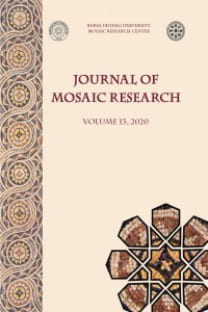From Antiquity to Modernity
It is not possible to mention my art without mentioning important exhibitions which have made possible the transi- tion from antique mosaics to contemporary mosaics in Turkey. This is important in the name of determining where I stand in the historical progression. The important exhibitions opened during these time periods have elevated the art of mosaic from the antique value to contemporary merit. These exhibitions have been an obstacle to the death of this significant art and have formed the backround that made it possible to continue into contemporary works of art while standing firmly on the past. How does something which belongs in the past go on to the future? With the exception of the mosaics and fres- coes which reflect the restrained and religious level of the middle ages, the issue of the resolution of the subjects of architecture and art in their entirety was in the beginning, fragmented and in a state of confusion in the western countries and Turkey. In the end, the developmental process was realized with the Bauhaus School. This school, founded in 1919 and aiming to join fine arts and architecture, re-opened the doors to mosaic, which gives pictures an extended life. During the initial periods of the republic in Turkey, with the orders of Atatürk the government’s sensitivity to art was increased. Historical works were first restored during this period and the first archeological digs were made. This way, the many valuable mosaics which were brought to light influenced a great many artists. By way of these artists, the art of mosaic could get out of the frame of antiquity and began to be respected once again by people who valued this art. While wall pictures were not thought of during this period, Bedri Rahmi Eyüboğlu emerges during this time. His pioneering during this time and the ground he set up for us artists is significant. The first Ravenna mosaic exhibition, which was prepared by the Italian Culture Board and our Ministry of Educa- tion, was opened in 1961 in Hagia Irene. The mosaics in Istanbul were destroyed by design breaker “Iconoclasts”. Because opposition to depiction didn’t affect Italy all the mosaic designs from the 6th Century A.D. were saved. This first exhibition of Ravenna mosaics brought the East Roman “Byzantine” Empire’s western golden age to the door of our 1960 artists. Staying faithful to the rules of antique works, one copy was made of each work by the Ravenna students. In 1971 in the Picture Sculpture Museum the modern mosaic exhibition was opened this time again by the Italians. These modernized works which were made with the influence of the antique works have enrichened the thoughts and imaginations of our artists on this subject. This exhibition which was the foundation of contemporary mosaic picture art, has displayed the mastery of mosaic technique, the artist working in a creative manner. In 1956, Eren and Bedri Rahmi Eyüboğlu made two giant mosaic panels for the Etibank Executive building in Ankara. They displayed these panels in the Maya Art Gallery in Istanbul. Although these panels were presented to the viewer before assembly, they are important for being the first mosaic exhibition by a Turkish artist after the mosaic exhibitions we mentioned before. After these exhibitons, the artists of that period got the opportunity to make mosaic panels in architecture between the years 1956-1970. Our artists re-handled the art of mosaic by giving old techniques new forms. Entering the contemporary architecture, they proved the necessity of the complementary nature of the building and work of art by way of colorful mosaic paintings which were put on dead walls. After 1956, we come across a personal mosaic exhibition opened in 1992 in the Hagia Sophia by Hülya Vurnal İkizgül (me). In this exhibition, there were mosaic pictures and mosaic sculptures of big dimensions. These were totally detached from architecture. With these works, which were not made for a work of architecture, the art of mosaic proclaimed its individuality and independence. This destroyed the taboo“the art of mosaic is a whole with architecture”. Being detached from architecture and having big dimensions, these works of art, some of which had
